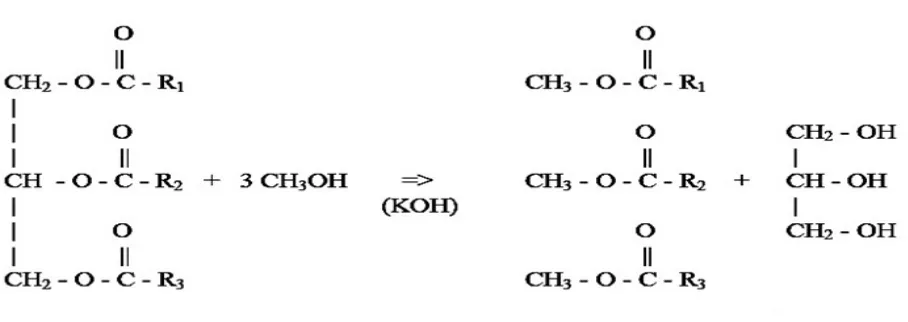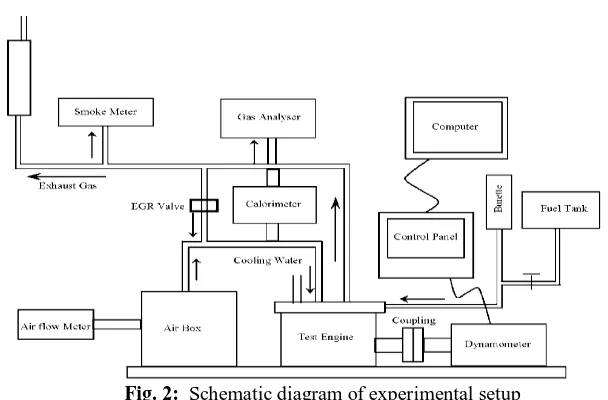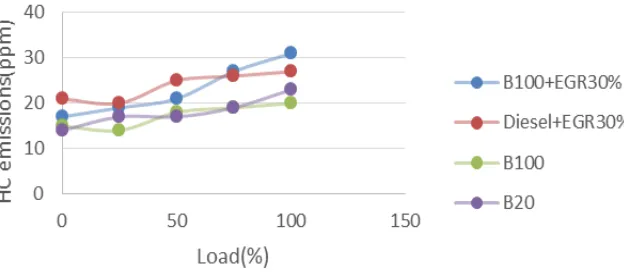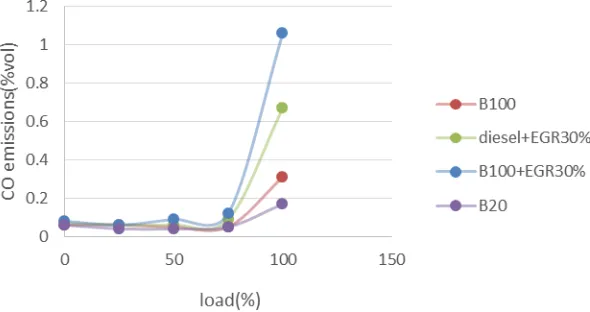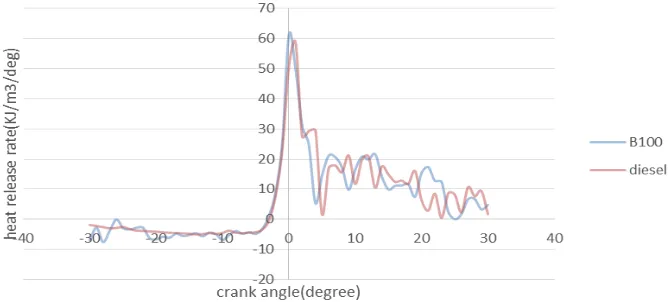e-ISSN: 2278-067X, p-ISSN: 2278-800X, www.ijerd.com Volume 7, Issue 8 (June 2013), PP. 18-25
The Effects of Exhaust Gas Recirculation on Exhaust
Emission and Combustion Characteristics of a CI engine
operated on Diesel and WCO Biodiesel
Arindam Pal
1, Charan Samanchi
2, Sumit Sharma
31,2,3
School of Mechanical and Building Sciences, VIT University, India
Abstract:- Biodiesel has come to a forefront to be an alternative fuel to diesel in CI engines to reduce the diesel consumption and reduce the environmental degradation. The objective of this work is to elicit the problem with Biodiesel usage results in higher NOx emissions when compared to Diesel Engines and to reduce the NOx emissions with the help of Exhaust Gas Recirculation (EGR). CO, HC, NOx and smoke concentration of the exhaust gas were measured to estimate the emissions characteristics of a single cylinder four stroke air cooled direct injection (DI) diesel engine. Detailed analysis of various blends of biodiesel and diesel was made, to elicit the precise benefits of its extensive usage in CI engines. This analysis showed results indicating reduction in NOx emissions with the help of EGR with little compromise in power output.
Keywords:- Transesterification , Waste cooking oil (WCO), Exhaust emission, Diesel Engine, Exhaust Gas
Recirculation (EGR), Combustion characteristics, Pressure crank angle.
I. INTRODUCTION
Today World Is In The Age Of Industrialization And Excessive Need Of Fuel Has Compelled It, To Confront With Twin Crisis Of Fossil Fuel Depletion And Environmental Degradation. Indiscriminate Extraction And Lavish Consumption Has Led To Reduction Of Carbon Resources[1]. While Fossil Fuels Are Still Being Created Today By Underground Heat And Pressure, They Are Being Consumed More Rapidly Than They Are Created. For That Reason, Fossil Fuels Are Considered Non-Renewable: That Is They Are Not Replaced As Soon As We Use Them [2-3]. Hence, Alternative Energy Resources Such As Biodiesel From Various Edible And Non-Edible Oils Such As Soya Beans, Jatropha (Jatropa Curcas ), Sunflower And Karania ( Pongamia Pinnata) Has Started Attracting Significant Attention From Researchers, Governments , And Industries As A Renewable, Biodegradable, And Non-Toxic Source.
Rudolf Diesel invented the diesel engine, he demonstrated it at the 1990 world exhibition in Paris, employing peanut oil as fuel and said “The use of vegetable oils for engine fuels may seem insignificant today, but such oils may become in course of time as important as petroleum and the coal tar products of the present time” [4]. Bio fuels has been considered as a potential alternative fuel for internal combustion engines [1,4-7]. It has been found that it is not only renewable, but has zero net production of CO2 gas on global context. Moreover, thermodynamic tests based on engine performance evaluations, have proved their low volatility and high cetane number which makes them hold immense promise as alternative fuels. Many researchers have found that diesel engines run successfully for longer durations and the performance and emission characteristics are quite comparable to petroleum diesel engines [8-10]. Kalligeros et al. conducted test with biodiesel produced from sunflower oil and olive oil in a single cylinder stationary diesel engine and found lower particulate matter, carbon monoxide, hydrocarbons and nitrogen oxide emissions with a slight increase in volumetric fuel consumption [11]. Altiparmak et al. conducted tests with tall oil methyl ester in direct injection diesel engine and found lower CO emissions, lower sulphur content, higher torque and engine power output at higher engine speeds[12]. But the usage of edible and non-edible vegetable oil makes the process of production of bio fuels very expensive and also puts immense pressure on feedstock. The feedstock includes almost 75% of the cost of production of biodiesel. So keeping this aspect in mind a new though easily yet viable source is found that is waste cooking oil.
In automobiles with compression ignition engines, fuel like diesel are preferred prime movers due to excellent drivability and higher thermal efficiency. Besides their advantages, they emit large amounts of exhaust gases which contain green house gases and other gases like NOx, CO and smoke etc which cause damage to people’s health. Due to these effects, human beings may suffer from various diseases, such as lung cancer, breathing difficulties, poisoning and skin cancer etc. Hence, there is a need of controlling diesel engine emissions[13].
characteristics. This method is adapted in the modern automobile and other medium sized and large engines. However, technologies like Exhaust gas Recirculation (EGR), soot traps and exhaust gas after treatment are vital to cater to problems posed by stringent environmental emission rules [17]. EGR is where a part of exhaust gas is recirculated to intake so as to decrease the amount of oxygen available for nitrogen and also to reduce flame temperatures which results in reduction in NOx emissions. The specific heat of the EGR is much higher than fresh air, hence EGR increases the heat capacity (specific heat) of the intake charge, thus decreasing the temperature rise for the same heat release in the combustion chamber. Even though EGR application results in higher specific fuel consumption, it is the most effective way of reducing NOx emissions from compression ignition (CI) engines and is widely used in order to meet the emission standards.
The objective of the present work is to investigate the effect of exhaust gas recirculation with WCO and diesel fuel on the reduction of NOx emissions and also to investigate the pressure crank angle, combustion
characteristics, heat release and emission characteristics of a diesel engine with biodiesel as fuel with and without EGR at percentage like 30%EGR under the same load conditions.
II. BIODIESELPREPARATION
A. Retrieving the WCO
WCO was collected from different hotels, restaurants, canteen and cafeterias. The sample was allowed to settle for 2-3 days and vacuum filtration was done to separate unnecessary impurities and food residues.
B. Pre-heating WCO
Before transesterification process, to ensure that the oil contained very little amount of water droplets in it , the filtered WCO was subjected to pre-heating to 100 degree Celsius for 15 minutes with continuous stirring using magnetic stirrer. This helped in drying the oil.
C. Neutralization of free fatty acids
In the accumulated WCO, neutralization of free fatty acids (FFA) needs correct amount of catalyst for avoidance of soap formation. To determine the correct amount of catalyst required , a titration was performed on the oil to be transesterified. The sample was tested with pH paper and pH was kept to between 8-9. KOH of weight 1 gram was measured using electronic weighing balance and its solution with 10ml water (solution A). Another solution of 10 ml of iso-propyl alcohol and 1 ml of oil sample was made (solution B). Then, solution A was added drop wise into solution B to achieve pH between 8-9 to determine the equivalents of KOH required to neutralize FFA.
D. Alkali catalysed transesterification of WCO
The alkali catalyzed transesterification was performed due to presence of majority of free fatty acids in WCO. For transesterification of WCO in laboratory, oil was heated in a flat bottom conical flask upto 60 degree Celsius. To ensure the prevention of methanol to reach its boiling point (78deg C), the optimum reaction temperature was set to be 60 degree C. Equivalent of KOH determined from the neutralization of FFA process was added to the standard KOH value to get the required KOH weight in grams that is to be added to the reaction vessel. This KOH weight in grams was dissolved in 200 ml of water (Solution C).
Fig. 1: Transesterification Reaction
The reaction products were poured into a separating funnel and kept for approx. 6 hours for gravity separation of glycerol with WCO methyl esters. The glycerol forms a lower layer due to higher density, which is separated out. This oil recovered from the separating funnel was again subjected to same procedure with 80 ml of solution C to remove the traces of glycerol and retrieve better quality of bio diesel from the WCO.
This biodiesel is then blended with petroleum diesel and various blends such as B20, B40, B80 and B100 are prepared for conducting CI engine experiment for performance and emission characteristics. Proper characterization of biodiesel blends and petroleum diesel is also done in laboratory as per ASTM norms. Specific gravity of blends and kinematic viscosity is measured using Red Wood Viscometer.
Table I: Fuel properties
S. NO Fuel Viscosity (at
500C) (Nsec/m2)
Density (Kg/m3)
Flash point (0C)
Fire point (0C) 1 B20 0.007516 860 62 68
2 B40 0.009657 865 66 72
3 B80 0.009398 875 76 85
4 B100 0.008439 900 80 89
5 Diesel 0.007270 840 78 86
EXPERIMENTALSETUP
A four stroke single cylinder air cooled diesel engine typically used in utility vehicles was used for conducting the engine performance tests. The specifications of the engine are given in the table 2. The engine was coupled with AVL PRESSURE transducer GH14D/AH01, AVL INDIMICRA 602-T10602A , AVL digas 444 (five gas analyser) and AVL 437C Smoke meter for simulating the testing conditions. Data for engine speed (rpm), exhaust gas temperature, smoke meter reading, voltage , current etc. was collected from different types of sensors. Load was varied with the help of current variations.
Exhaust gas emissions were measured by the exhaust gas analyser. It measured CO, HC, CO2, O2, NOx and Air/fuel mixture. The exhaust gas smoke opacity was measured by AVL 437C Smoke meter.
Table II: Specifications of Engine
Type of engine Four stroke, Vertical air cooled diesel engine Number of cylinder Single
Bore/Stroke 87.5/110 Compression ratio 17.5:1 Rated power 4.4 KW Rated speed 1500 rpm Injection timing 230 Injection pressure 200 bar
Fig. 2: Schematic diagram of experimental setup
Engine tests were conducted according to Indian Standard Codes [15-17]. According to this, engine performance parameters such brake power efficiency, smoke opacity, emissions etc. were measured for each blend. The engine was operated at 1500 rpm and data collections for combustion parameter, emission and performance was done. This data was recorded at various loads of 0, 25, 50, 75 and 100%. The average of three readings was reported in this paper.
The basis of this is the amount of flow can be only as high as 30% of the total intake. EGR combines with the exhaust residual left in the cylinder from the previous cycle to effectively reduce the maximum combustion temperature. Two blends with EGR 30%, B100 and pure diesel at different engine loads are run under the specified engine and the results are tabulated and the resultant pressure-crank angle graphs are plotted accordingly.
Fig. 3: Actual Engine setup
III. EXPERIMENTAL INVESTIGATION
A. Nitrous oxide (NOx) emissions
Fig. 4: Nitrous oxide emission at various loads
B. Unburnt hydrocarbons (HC)
One of the side effects of EGR is increase in amount of unburnt hydrocarbons. Figure 2 shows the variations of HC emissions with change in loads. It was observed that HC emissions increases with increase in load. As the load increases, the amount of fuel injected also increases and due to this, the corresponding rise in emissions can also be noticed. HC emissions are higher with increase in EGR rate as oxygen availability decreases. B20 is having low HC emission since adding biodiesel increases presence of molecular oxygen in biodiesel and hence full combustion occurs reducing HC emissions.
Fig. 5: Hydro carbon (HC) at various loads
C. Smoke emission characteristics
Smoke opacity also increases with respect to all loads due to dissociation of gases. Figure 4 shows the variation of emissions with load. Due to lack of sufficient oxygen in fresh charge mixture, incomplete combustion occurs hence emissions are higher in case of EGR. B100 is giving considerable emissions at all loads when compared to that of diesel+ EGR 30% which gives more emissions at higher loads.
Fig. 7: Carbon monoxide emissions at various loads
E. Comparison of combustion characteristics
Fig. 7: Comparison of diesel and B100 with 30% EGR at 75% load
The whole combustion process in CI engine can be divided into four stages namely ignition delay, uncontrolled combustion phase, controlled combustion phase followed by after combustion phase. A comparative study between diesel and biodiesel at 75% load is done in figure 5 to analyse the combustion characteristics of pure biodiesel (B100) using EGR 30%.The path of phase1 (ignition delay) is found to be similar in both B100 and normal diesel. But the length of preparatory phase (ignition delay) in case of B100 is slightly more. In the phase of uncontrolled combustion, maximum pressure and maximum of rate of heat release is achieved.
Maximum pressure is achieved at 9o after TDC in case of B100 and 8o after TDC in case of diesel. Peak pressure is slightly more in case of B100. This is explained on the basis of ignition delay period. The longer the delay, the more rapid and higher the pressure rise since more fuel would have accumulated in the cylinder during the delay period. However, this rise is almost negligible and doesn’t cause any significant change in the compression ratio and combustion characteristics. And moreover these changes are more likely to occur at higher loads only.
F. Comparison of pressure crank angle characteristics
combustion characteristics is almost same with no rise in peak pressure and not much change in the heat release rate.
Fig. 8: Pressure crank angle diagram for B100+EGR 30% at different loads
Fig. 9: Pressure crank angle diagram for B100 without EGR at different loads
G. Comparison of heat release
The below graph represents heat release rates between B100 and pure diesel with 30% EGR. It was observed that heat release for B100 was more than diesel. It can be clearly seen at highest peak in figure 8. The reason might be due to presence of small amounts of residual methanol in biodiesel, which burns and increases the heat release in the initial/middle stages of combustion. This can be also due to the improved combustion of biodiesel since it has highest cetane number delivering improved combustion characteristics. The same conclusion can be drawn for other blends also.
Fig. 10: Heat release rate diagram for diesel and B100 with 30% EGR
IV. CONCLUSIONS
In this study, the properties and combustion characteristics of biodiesel produced from waste edible oil has been determined and these are compared to normal diesel. Also a study on EGR is done on both pure biodiesel (B100) and diesel and the effects of various emission properties is determined. Following are some of the statistical results from the above discussion.
Although NOx emissions can be controlled using EGR process, a costly price of increased HC emissions
We Would Like To Thank Our Faculty In-Charge K.Nanthagopal For The Immense Support And Help. We Would Not Have Been Able To Complete The Comparative Investigation And Study Of The Blends And Emission Characteristics. We Would Also Like To Thank The Vit University And Sri Venkateswara College Of Engineering For The Resources To Help Us In Providing The Required Engine Setup For Our Project.
REFERENCES
[1]. Agarwal A K, Biofuels (alcohols and biodiesel) applications as fuels for internal combustion engines, Progress in Energy and combustion sciences, 33, 2007, pp 231-277.
[2]. Nanthagopal K, Rayapati Subbarao, “Experimental investigation and performance evaluation of DI diesel engine fueled by waste oil- diesel mixture in emulsion with water”, Thermal Science,2009, 13(3): pp.83-89.
[3]. Zafer Utlu, Mevlut Sureyya Kocak, “ The effect of biodiesel fuel obtained from waste frying oil on direct injection diesel engine performance and exhaust emissions”, Renewable Energy, Volume 33, 2008, pp: 1936-1941.
[4]. Krawczyk T, Biodiesle- Alternative fuel makes inroads but hurdle remains, INFORM 7, 1996, pp 801-815.
[5]. Freedman B, Pryde E H, Mounts T H, Variables affecting the yields of fatty esters from transesterified vegetable oils, JACOS 61, 1984, pp 1638-1643.
[6]. Freedman B, Pryde E H, Mounts T H, Variables affecting the yields of fatty esters from transesterified vegetable oils, JACOS 61, 1984, pp 1638-1643.
[7]. Ali Y, Hanna M A, Alternative diesel fuels from vegetable oils, Bioresource Technology, 50,1994, pp 153-165.
[8]. Altin R, Cetinkaya S, Yucesu H S, Potential of using vegetable oil fuels as fuel for diesel engines, Energy conversion & Management, 42, 2001, pp 529-538.
[9]. Scholl K W, Sorenson S C, Combustion of soybean oil methyl ester in a direct injection diesel engine, SAE 930934.
[10]. Srivastava A, Prasad R, Triglycerides based diesel fuels, Renewable and Sustainable energy reviews, 2000, 4, pp 111-133.
[11]. Kalligeros S, Zannikos F, Stournas S, Lois E, Anastopoulos G, Teas C, Sakellaropoulos F, an investigation of using biodiesel/marine diesel blends on the performance of a stationary diesel engine, Biomass and Bioenergy, 2003, pp 141-149.
[12]. Altiparmak D, Keskin A, Koca A, Guru M, Alternative fuel properties of tall oil fatty acid methyl ester- diesel fuel blends, Bioresource technology, 98. 2007, pp 241-246
[13]. Jinlin Xuea, Tony E. Grift, Alan C. Hansen, “Effect of biodiesel on engine performances and emissions”, Journal of Renewable and Sustainable Energy Reviews, Volume15, 2011, pp: 1098-1116. [14]. Md. Nurun Nabi, Md. Shamim Akhter, Mhia Md. Zaglul Shahadat, “Improvement of engine emissions
with conventional diesel fuel and diesel–biodiesel blends”, Journal of Bioresource Technology, Volume 97,2006, pp: 372-278.
[15]. Magin Lapuerta, Octavio Armas, Jose´ Rodrı´guez-Fernandez, “Effect of biodiesel fuels on diesel engine emissions”, Journal of Progress in Energy and Combustion Science, Volume 34,2008, pp:198-223.
[16]. Tsolakis.A, Megaritis.A, “Exhaust gas reforming of rapeseed methyl ester for reduced exhaust emissions of CI engines”, Biomass & Bioenergy, Volume 27, 2007, pp: 493- 505.
